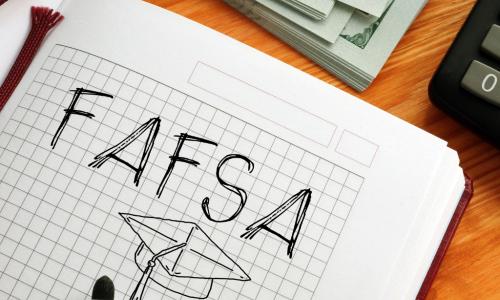VSAC transferred the servicing of your Federal Student loans to American Education Services and the guarantee of all VSAC Federal Student loans to the Trellis Company, an approved Federal Guaranty Agency, over the weekend of March 16th. CLICK HERE for more information.
New federal student aid forms for 2024-2025: 8 important things to do right now

The U.S. Department of Education has promised that the 2024/2025 Free Application for Federal Student Aid Forms (FAFSA) – the new, revised Free Application for Federal Student Aid – will be available in late December. The FAFSA is a requirement for almost all college financial aid programs, from federal loans to school-provided financial aid to private scholarships.
If you’re interested in college or training next year (especially if you’ll have extra time on your hands over the holidays!), your family doesn’t need to wait until the FAFSA form is released to get started on the process. Even though the FAFSA’s availability changed, many submission deadlines for schools, scholarship grantees, and loan programs are the same. So here are 8 steps you can do in the meantime.
1. Start researching schools and programs
Make a list of schools or programs that interest you (even a little bit). When you’re researching, focus on:
- location,
- fields of study offered,
- average cost of attendance,
- institution size, and
- admissions and graduation rates.
VSAC offers a comprehensive list of tips for Comparing Colleges or Training Programs, as well as a free comparison chart template that you may find helpful.
2. Take a tour and meet with admissions counselors

While you’re making notes on what’s important to your college experience and shortlisting your top schools, start planning tours and interviews. Whether you want to visit in-person or online, reach out to each school’s admissions office to schedule an interview. If you can’t visit in-person, visit each school’s website and social media channels to view videos of campus life, or take a virtual tour.
Many schools track “demonstrated interest” – whether you’ve shown an intentional interest in their school. In addition to campus visits, schools may look at whether you're opening their emails, interacting with their social media posts, meeting with their reps at college fairs and filling out their inquiry cards, and more. To find out how much emphasis your school places on your interest (and more about schools’ application criteria), use an online search site and input a college’s name paired with the phrase, “Common Data Set” (e.g., search: VSAC University Common Data Set).
3. Apply to your favorite schools/programs
Download application forms, materials, and essay prompts (if applicable). After you’ve read all the requirements and have all the deadlines on your calendar, start planning your application submissions. Many schools waive the application fee if you apply within a certain time, or if you have visited the school and participated in a tour. Applying as early as possible (without short-changing your application) is always best.
4. Create an FSA ID
Before you start filling out the FAFSA, you’ll need a username and password, also called a “Federal Student Aid ID.” The student and at least one, or sometimes, both parents (or in FAFSA-speak, “contributors”) will each need their own individual FSA ID or Federal Student Aid Account. While in the past, applicants for an FSA ID could use their username and password immediately to file a FAFSA, this year, the government is taking some additional verification steps in issuing FSA IDs. People contributing information on a FAFSA must now wait 3-5 business days after creating an FSA ID for the government to confirm their ID can be used.
VSAC counselors suggest that it is more important than ever that families do that part of the process now (it’s a short online process that takes about 10 minutes). And once you’re done, keep all usernames and passwords handy for when they fill out the FAFSA.
To create an FSA ID, each person will need their own email address (VSAC counselors are prepared to help people create free Gmail addresses if necessary) to complete that process. We can provide that assistance virtually, you can set an in-person appointment at our Winooski Resource Center or you can contact us with questions.
5. Gather all the info you’ll need to complete the FAFSA
Taking some time now to get all your files pulled, passwords recovered, and/or your statements printed can reduce stress later on. Depending on your personal circumstances, you may need the following items:
- The name, date of birth, Social Security Number, and email for the people required to contribute information to your FAFSA, also called contributors. Your contributors are often parents, or a spouse if FSA considers you an independent student. Visit the Federal Student Aid YouTube to learn who is considered a contributor on the FAFSA.
- 2022 federal income tax returns and W2s, child support information (if applicable), and other personal information.
- Alien registration number (if you’re not a U.S. citizen).
- Records of untaxed income (like contributions to IRA, SEP/SIMPLE plans, or tax-exempt interest).
- Bank records (cash, savings, checking account balances).
- Investment information (such as investment property or stocks/bonds not in a qualified retirement plan. Qualified retirement savings, as well as contributors’ primary home, are not reported on the FAFSA).
- The net worth – value minus debt – of your contributors’ business(es) and/or family farm, if applicable.
- Your colleges: You must list at least 1 college to receive your information. You may update your choices later to apply for aid at a different school.
6. Research and apply for grants and scholarships

Two of the best resources for Vermont students are the Vermont Grant, available only to Vermont residents, and the 150-plus VSAC-managed scholarships, primarily available to Vermont residents.
Vermont Grants are free “gift aid” based on financial need, so you don’t need to pay them back. But you DO need to apply. To apply for a Vermont Grant you’ll also need to complete the FAFSA when it’s available; VSAC will receive your FAFSA information by the beginning of February. And even if you fill out the Vermont Grant application before you fill out the FAFSA, we’ll automatically match your FAFSA information with your Vermont Grant information when we receive it.
VSAC-managed scholarships range in amount, terms and eligibility. Our 2024-2025 scholarship booklet includes information on 150 scholarships administered by VSAC, plus an additional 41 scholarships run by outside organizations. There are scholarship opportunities for a variety of academic interests, such as business, health care, education, and many more. There may be specific scholarships for residents of your town or county, graduates of your high school, or members of traditionally disadvantaged groups. The annual award amounts generally range from $500 to $6,500, though there are some exceptions. The Scholarship Booklet is available now, and required application materials are due to VSAC by February 14, 2024.
Finally, you should also check with your school(s) financial aid offices to see if additional financial aid forms are required, such as the CSS Profile. School-specific scholarships and grants may also be available. If you're interested in other Federal grant programs, including Pell grants, FSEOG grants, TEACH grants, and Iraq & Afghanistan service grants from the U.S. Department of Education you automatically apply to these programs by filing your FAFSA.
7. Stay on top of deadlines. Follow your plan.
Mark application deadlines for school admissions, grants, scholarships, and eventually, the FAFSA in your phone or desktop calendar, or any other time-management system you use. There are no extensions or grace periods if you’re late, so missing a deadline could cost you admission to your preferred program or several thousand dollars’ worth of financial assistance. Plus, many grants and scholarships are awarded on a first-come, first-served basis until funding runs out. So, it literally pays to be on time or early!
8. Contact VSAC for help or to answer questions
The process of applying to higher education and training programs, and to the financial aid systems that support them, is complicated enough. This year, the FAFSA form revisions add another layer of complexity and shortened the time window by three months. If you have questions or are feeling overwhelmed, don’t wait to reach out. We’re here to help.





